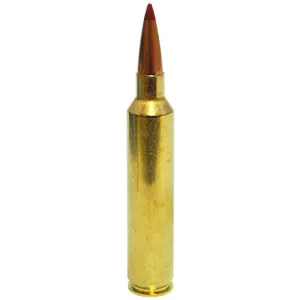
The term proprietary cartridge is used to describe a cartridge design that is owned by an individual or company under a registered trademark or patent. A patent is an official document granting the exclusive right to make, use, and sell an invention for a limited period. A trademark can be a name or symbol which identifies a product that is officially registered and legally restricted to the use of the owner or manufacturer. Put simply, a proprietary cartridge can only be produced commercially by either the owner of the patent or trademark - or any company that has a licensed agreement with the patent/trademark holder.
Traditionally, proprietary cartridges have always achieved only limited success due to either high cost of ammunition or limited availability of ammunition. A classic example is the .375 Holland & Holland Magnum which did not achieve full acceptance or popularity until its patent expired during the mid 1920’s. Roy Weatherby’s magnums were also proprietary cartridges at one time and like Holland & Holland, Weatherby targeted the wealthy, essentially a money making exercise. Nevertheless the Weatherby cartridges were so effective in performance that they were either emulated in design or later adopted by major manufacturers.
Readers are advised that, due to cost and availability issues, I have very little experience with the Dakota cartridges therefore; the information ahead must be regarded purely as a basic reference. The advertised velocities for the Dakota cartridges are, from what little experience I have, true to claims and hand loads also duplicate factory performance. Beyond this, the reader must compare terminal performance with other like-velocity cartridges which can be found throughout this knowledge base.
Proprietary cartridge design has always been a major influence in the development of mainstream cartridges for better or in some instances, for worse. The interest generated by certain proprietary cartridges, especially when the interest comes from middle to low income earners, has allowed the major U.S giants to design ‘like’ cartridges. Such was the case during the 1990’s when Don Allen introduced his Dakota cartridges (the exclusive Lazzeroni cartridges were also a major influence). By 1999, these cartridges had sparked enough interest worldwide to inspire Remington and Winchester to develop their own beltless magnum cartridges. To some extent, the hype surrounding the Dakota and Lazzeroni proprietary cartridges reached a point at which competition between Remington and Winchester became so fierce that their designs were rushed. Both brands have since suffered from this. The most recent mainstream manufacturers to adopt the Dakota proprietary design has been the Ruger Hornady collaboration in the form of the .375 Ruger which is near identical to the .375 Dakota.
The Dakota cartridges were designed by the Late Don Allen (1941- 2003). His designs were based on the formed brass he purchased from Noburo Uno. Noburo Uno and Aubrey White of North American Shooting Systems (NASS), based in British Columbia Canada, began experimenting with the full length .404 Jeffery in the early 1980's. Allen founded Dakota Arms in 1986, initially building high end custom rifles. In 1992, Allen introduced his Dakota proprietary cartridges. Of all the magnum cartridges ever created, the Dakota line features immensely effective case capacities. All but one of the Dakota cartridges are based on the .404 Jeffery case shortened to around 2.5”. The 2.5” case length duplicates many traditional magnum length cartridges, minimizing problems with undersized magnum action magazines.
The 7mm Dakota produces maximum potential velocity from the 7mm bore without excessive throat erosion and heavily reduced barrel life. In contrast, the 7mm RUM with its longer case utilizing approximately 7 to 10 grains more powder, crosses the line and is heavily over bore. The .300 Dakota has a very well balanced case to bore ratio.
The case rim diameters of the Dakota cartridges are different to the WSM and Remington beltless magnums. Rather than being rebated to work with standard bolt faces, the Dakota 2.5” cartridges utilize the full width of the parent .404 Jeffery case head at .454”. Because of this, many shooters are currently wildcatting the .375 Ruger, necking it down to 7mm and .30 caliber etc, in order to duplicate the performance of the Dakota cartridges at a far lower cost.
Factory Dakota ammunition has a small level of bullet jump similar to typical SAAMI spec ammunition in traditional calibers. Hand loads can be tailored for minimum bullet jump at around 3.6" COAL in the 7mm and .30 calibers.
The largest of the Dakota cartridges is the .450 Dakota. For a while, Dakota advertised a .416 cartridge but this is no longer in production. Unlike its siblings, the .450 cartridge is based on the .416 Rigby case, much like the .338 Lapua Magnum. Case capacity is near identical to the .460 Weatherby, the main difference between the two cartridges being that the .460 is loaded as fast as possible, apart from this, freebore is much the same.
The downside of the Dakota cartridges include the high cost of brass, the lack of readily available factory ammunition along with the non standard case head design. This last issue is unfortunately the major limiting factor regarding the mainstream popularity of the Dakota cartridge line.
One factor that Dakota have incorporated into their cartridge designs, especially in the 7mm and .30 caliber, is a long neck for optimum bullet to bore concentricity during ignition, a great aid to accuracy.





